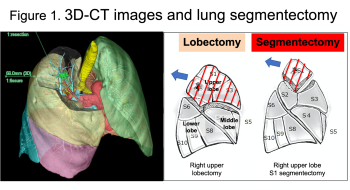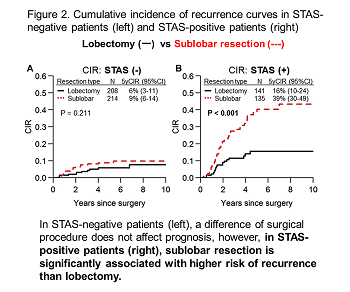
- HOME >
- GRADUATE >
- Human Sciences >
Surgery(Thoracic)

| Master's Program | Medical Science Division, Department of Medical Science, Graduate School of Medicine, Science and Technology |
|---|---|
| Doctor's Program | Biotechnology Division, Department of Biomedical Engineering, Graduate School of Medicine, Science and Technology |
| Professor | SHIMIZU Kimihiro |
|---|---|
| Associate Professor | HAMANAKA Kazutoshi |
| Senior Assistant Professor | EGUCHI Takashi |
| Assistant Professor | KUMEDA Hirotaka |
E-mail : gts(at)shinshu-u.ac.jp
※ Change (at) to @ when you send an e-mail.
Our research focuses on 1) regional anatomy of the lung, 2) a regeneration of the lung tissue, and 3) a clinical and molecular pathology of lung cancer, which is one of the most common cancers with the highest mortality rate. We specifically investigate segmental anatomy of the lungs utilizing three-dimensional computed tomographic (3D-CT) images to develop novel surgical strategies to preserve lung volume in patients. We aim to integrate the lung regeneration technologies and the novel molecular targeting treatment into the lung preserving surgical strategy to provide safer and oncologically more effective treatment for lung cancer.

1) Development of the novel segmentectomy based on an investigation of the regional lung anatomy utilizing 3D-CT images: The standard surgery for lung cancer is a lobectomy. With an increasing detection of patients with early-stage disease especially in elderly patients who frequently have co-morbidities, however, a lung-preserving strategy such as a segmentectomy has been widespread. We have investigated detailed segmental anatomy of the lungs extensively using 3D-CT images (Figure 1) in individual patients to develop a novel, tailor-made segmentectomy that can preserve both lung volume and oncological effectiveness based on anatomical/oncological findings of the individual patients. We also engage in integrating minimally invasive approach such as video-assisted thoracic surgery into lung-preserving surgery. (Publications No 1, 2)
2) Validation of the regeneration of lung tissue after segmentectomy and development of the novel treatment strategy based on combined lung regeneration and segmentectomy: It has been thought that the lung tissue would not regenerate after lung resection. In clinical practice, however, we have experienced "regrowth" of the lung tissue within the residual lungs after segmentectomy. Previous animal model-using studies have investigated lung regeneration after lobectomy or pneumonectomy, which might have evaluated not only lung regeneration but also overexpression of the lungs as a result of physical stimulation. We hypothesize that lung regeneration could occur after segmentectomy, in which resipdual lung tissues could play a role as scaffolds for lung regeneration. We are developing an animal model to test whether lung regeneration occur after segmentectomy. In the next step, we plan to investigate how we can facilitate lung regeneration and a subsequent improvement of lung function by modifying the extend of resection and/or technique to incise the lung tissues using the animal model. In the future, we aim to investigate collaborative research between a lung regeneration strategy and an iPS technology.

3) Personalized oncological research for the lung cancer: We, as thoracic surgeons treating individual patients with a lung cancer, analyze various parameters of patients to determine who benefits from surgical treatment. (Publications No. 3, 9) In addition, we are conducting molecular and/or clinicopathological research projects to clarify characteristics of lung cancer . (Publications No. 4, 6, 8, 10) (Figure 2)
4) Development of CAR T-cell therapy for lung cancer (collaborative project with Department of Pediatrics): CAR T-cell therapy, new immunotherapy, is clinically used for hematological malignancies such as refractory leukemia. We investigate and develop a clinical application of CAR T-cell therapy for small cell lung cancer and non-small cell lung cancer. Until now, CAR T-cell therapy has been considered ineffective for solid cancer such as lung cancer. However, if we can prove the effectiveness of CAR T-cell therapy for lung cancer, it can be a precursor to CAR T-cell therapy for other solid tumors.
5) Other projects: We are conducting research projects investigating metastatic lung tumors (Publication No. 7) and thymic epithelial tumors (Publication No. 5) as well.
1. Shimizu K, Nagashima T, Ohtaki Y, et al: Analysis of the variation pattern in right upper pulmonary veins and establishment of simplified vein models for anatomical segmentectomy.
Gen Thorac Cardiovasc Surg 64: 604-11, 2016
2. Shimizu K, Nakazawa S, Nagashima T, Kuwano H, Mogi A: 3D-CT anatomy for VATS segmentectomy.
J Vis Surg 3: 88, 2017
3. Eguchi T, Bains S, Lee MC, et al. Impact of increasing age on cause-specific mortality and morbidity in patients with stage I non-small cell lung cancer: a competing risks analysis.
J Clin Oncol. 35: 281-290, 2017
4. Shimizu K, Ohtaki Y, Altan B, Yokobori T, Nagashima T, Arai M, Mogi A, Kuwano H: Prognostic impact of stathmin 1 expression in patients with lung adenocarcinoma.
J Thorac Cardiovasc Surg 154:1406-1417, 2017
5. Hamanaka K, Koyama T, Matsuoka S, et al.: Analysis of surgical treatment of Masaoka stage III-IV thymic epithelial tumors.
Gen Thorac Cardiovasc Surg 66(12):731-735, 2018
6. Miura K, Oba T, Hamanaka K, Ito KI: FGF2-FGFR1 pathway activation together with thymidylate synthase upregulation is induced in pemetrexed-resistant lung cancer cells.
Oncotarget 5:10(11):1171-1192, 2019
7. Shimizu K, Ohtaki Y, Okumura T, et al.: Outcomes and prognostic factors after pulmonary metastasectomy in patients with colorectal cancer with previously resected hepatic metastases.
J Thorac Cardiovasc Surg. 157(5):2049-2057, 2019
8. Shimizu K, Goto Y, Kawabata-Iwakawa R, et al.: Stathmin-1 is a useful diagnostic marker for high-grade lung neuroendocrine tumors.
Ann Thorac Surg 108(1):235-243, 2019
9. Hamanaka K, Miura K, Koyama T, Matsuoka S, Takeda T, Yamada K, Hyogotani A: The pretreatment circulating albumin-to-fibrinogen ratio in patients with non-small cell lung cancer: A simple, economical, and effective biomarker.
J Thorac Dis 11(3): 241-244, 2019
10. Eguchi T, Kameda K, Lu S, et al. Lobectomy is associated with better outcomes than sublobar resection in spread through air spaces (STAS)-positive T1 lung adenocarcinoma: A propensity score-matched analysis.
J Thorac Oncol, 14: 87-98, 2019